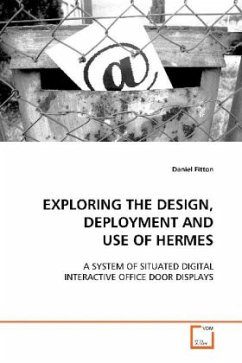This thesis explores the design, deployment and use
of a system of interactive display-based ubicomp
prototypes, referred to as the Hermes system. The
Hermes system provided a groupware application
supporting asynchronous messaging facilities to help
support awareness and coordination. Occupants of
offices equipped with Hermes displays were able to
manually share personal context in the form of short
textual messages or images. One novel aspect of the
work on Hermes was longitudinal deployment outside of
the lab which allowed exploration of adoption and use
from door display owners. A key aim of the work on
Hermes was the involvement of display owners in the
design process in order to avoid purely
technology-led design. This user-centred approach
generated valuable feedback to generate new
requirements and features to help inform the design
which would not otherwise have been available.
Additionally, the Hermes prototypes acted as a form
of technology probe. One particular challenge raised
by the need to support adoption and maintain use
during a longitudinal deployment was the requirement
for high levels of reliability.
of a system of interactive display-based ubicomp
prototypes, referred to as the Hermes system. The
Hermes system provided a groupware application
supporting asynchronous messaging facilities to help
support awareness and coordination. Occupants of
offices equipped with Hermes displays were able to
manually share personal context in the form of short
textual messages or images. One novel aspect of the
work on Hermes was longitudinal deployment outside of
the lab which allowed exploration of adoption and use
from door display owners. A key aim of the work on
Hermes was the involvement of display owners in the
design process in order to avoid purely
technology-led design. This user-centred approach
generated valuable feedback to generate new
requirements and features to help inform the design
which would not otherwise have been available.
Additionally, the Hermes prototypes acted as a form
of technology probe. One particular challenge raised
by the need to support adoption and maintain use
during a longitudinal deployment was the requirement
for high levels of reliability.








